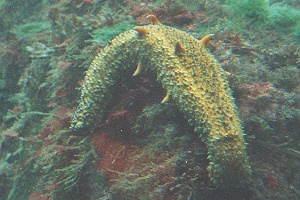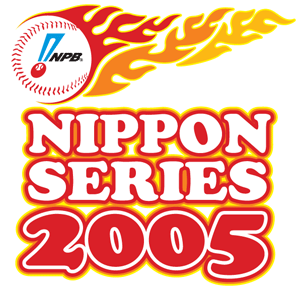
Sea cucumbers are echinoderms from the class Holothuroidea. They are marine animals with a leathery skin and an elongated body containing a single, branched gonad. Sea cucumbers are found on the sea floor worldwide. The number of holothurian species worldwide is about 1,717 with the greatest number being in the Asia Pacific region. Many of these are gathered for human consumption and some species are cultivated in aquaculture systems. The harvested product is variously referred to as trepang, namako, bêche-de-mer or balate. Sea cucumbers serve a useful role in the marine ecosystem as they help recycle nutrients, breaking down detritus and other organic matter after which bacteria can continue the degradation process.

The California sea cucumber, also known as the giant California sea cucumber, is a sea cucumber that can be found from the Gulf of Alaska to Baja California. It is found from the low intertidal zone to a depth of 250 m (820 ft). They are most abundant in areas with moderate current with cobbles, boulders or bedrock. They are artisanally fished.

The Stichopodidae are a family of sea cucumbers, part of the order Synallactida.

Apostichopus parvimensis, commonly known as the warty sea cucumber, is a Pacific species of sea cucumber that can be found from the Baja California Peninsula, Mexico, to Monterey Bay, California, USA, although only scattered individuals were reported to occur north of Point Conception, California. It is found mainly in low energy environments from the intertidal zone down to 30 m (98 ft), but can occur as deep as 60 m (200 ft).

Makoto Imaoka, nicknamed "Makochan", is a former Japanese professional baseball player from Takarazuka, Hyōgo, Japan.

Sea cucumbers are marine animals of the class Holothuroidea. They are used as food, in fresh or dried form, in various cuisines. In some cultural contexts the sea cucumber is thought to have medicinal value.

The 2005 Japan Series, the 56th edition of Nippon Professional Baseball's championship series, began on October 22 and ended on October 26, and matched the Central League champion Hanshin Tigers against the Pacific League Champion, Chiba Lotte Marines. It would become the most one-sided Japan Series in history, as the Marines outscored the Tigers 33-4 throughout the series. On the other hand, the Tigers had several worst records in the Japan Series, scoring only 4 runs, an earned run average of 8.63, and getting no home runs.

Lunch BoxakaBowling Ball is a 2004 Japanese pink film directed by Shinji Imaoka. It was chosen as Best Film of the year at the Pink Grand Prix ceremony.
Shinji Imaoka a.k.a. 羅門ナカ is a Japanese film director, screenwriter, and actor. He is one of a group of pink film directors of the 2000s known collectively as the "Seven Lucky Gods of Pink", which besides Imaoka, also includes Toshiya Ueno, Mitsuru Meike, Yūji Tajiri, Yoshitaka Kamata, Toshirō Enomoto and Rei Sakamoto.

Sopping Wet Married Teacher: Doing It in UniformakaDespite All That is a 1999 Japanese pink film written and directed by Shinji Imaoka. It was given Honorable Mention at the Pink Grand Prix ceremony.
A. californicus may refer to:
A. japonicus may refer to:

Holothuria leucospilota, commonly known as the black sea cucumber or black tarzan, is a species of marine invertebrate in the family Holothuriidae. It is placed in the subgenus Mertensiothuria making its full scientific name Holothuria (Mertensiothuria) leucospilota. It is the type species of the subgenus and is found on the seabed in shallow water in the Indo-Pacific.

Stichopus is a genus of sea cucumbers from the family Stichopodidae.

Synallactida is a rankless clade of sea cucumbers, but is referred to as an order. Taxa within Synallactida were previously classified in an order called Aspidochirotida, which was determined to be polyphyletic in 2017.

Asterodiscididae is a family of starfish. Members of the family have five short tapering arms and a wide disc. The family was first described by the Australian zoologist F.W.E. Rowe in 1977.

Asterodiscides is a genus of starfish. Members of the genus have five short tapering arms and a wide disc. The genus was first described by the British zoologist Ailsa McGown Clark in 1974.
Gekko shibatai is a species of gecko, a lizard in the family Gekkonidae. The species is endemic to the Ryukyu Islands.
Tenacibaculum holothuriorum is a Gram-negative and aerobic bacterium from the genus of Tenacibaculum which has been isolated from the sea cucumber Apostichopus japonicus from Xiapu in China.
Salegentibacter holothuriorum is a Gram-negative, strictly aerobic and non-motile bacterium from the genus of Salegentibacter which has been isolated from the sea cucumber Apostichopus japonicus from the Sea of Japan.













